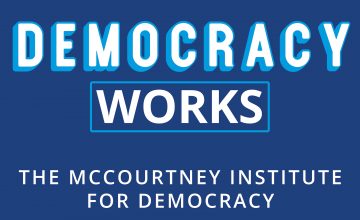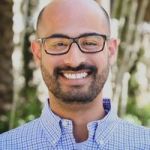Podcast: Play in new window | Download | Embed
Subscribe: Apple Podcasts | Spotify | Email | TuneIn | RSS | More
 Since we started this show, we’ve had the opportunity to speak with several organizers, from Joyce Ladner in the Civil Rights movement to Srdja Popovic in Serbia to the students involved with the March for Our Lives. Today, we think of protests as a pillar of democratic dissent, but things didn’t necessarily start out that way.
Since we started this show, we’ve had the opportunity to speak with several organizers, from Joyce Ladner in the Civil Rights movement to Srdja Popovic in Serbia to the students involved with the March for Our Lives. Today, we think of protests as a pillar of democratic dissent, but things didn’t necessarily start out that way.
L.A. Kauffman is a longtime organizer and author of the book How to Read a Protest: The Art of Organizing and Resistance. She traces the history of the modern protest movement since the March on Washington in 1963 and joins us to talk about what has — and has not — changed since then. If you are an organizer or have ever attended a protest, we think you’ll find L.A.’s insights interesting.
Additional Information
L.A.’s book, How to Read a Protest
Our episodes on protest and organizing:
Interview Highlights
[2:49] How was the 1963 March on Washington organized and what made it something that organizers today still look to?
This book and the 1963 march is about a particular kind of protest above all, which are mass mobilizations where huge numbers of people come together out in the streets. I hadn’t quite realized that before 1963, we never had anything on this scale in American history. It ended up bringing 250,000 people. One of the ways that the organizers compensated for those fears was by going on overdrive with an organizing model. We think of this as a high water point in American democracy, and yet the messages were so controlled, there was no room for individual voices there.
[6:00] What was it about that moment that lead to such a large event? Were there efforts to try something similar prior to that?
There was a march that was threatened during During World War II, but it never happened. The threat of a civil rights march over discrimination in the military forced FDR’s hand and led to desegregation. The scale of protests at the time were more like 25,000 or 50,000 people. No one had ever dreamed of an event that could bring together these large numbers of people.
[8:12] What compromises were necessary to make the march happen?
The very first idea of the 63 march in Washington was it was going to not just be a march, but it was also going to be an occasion for nonviolent civil disobedience. I mean, it was going to represent a real tactical escalation. And those plans got dropped almost immediately, as soon as the organizers began negotiating with the Kennedy Administration. The Kennedy Administration was walking a very complicated line, because they very clearly did not want the march to happen. And then once the march was clearly going to happen whether they agree to it or not, they did everything they could to control it. And part of that was by orchestrating the choreography of it so that it didn’t actually, they changed the march route, so that the march never went past the White House, or the Capitol.
[10:04] How does that approach compare to today’s model of organizing?
There was more disunity behind the scenes in the 1963 march than the mythology would lead you to believe, There weren’t open divisions and splits among the players, but they were definitely very substantial differences of opinion about strategy and direction of the movement, and a lot of internal tension. Sometimes those things stay behind the scenes, and sometimes they split out in the open.
When I look at what happened with the women’s marches, my takeaway is the resilience of the grassroots. There were more than 300 local events around the country, which I think is quite extraordinary three years on, and shows how much a movement that has many leaders, many organizing centers, can persist in ways that maybe are hard for the national media to see and perceive, but they have very powerful effects when it comes to things like organizing, get out the vote operations in the midterm elections.
[12:49] What can we learn about a protest from the signs that people bring to it?
The moment that first got me working on this book was when I attended the 2017 women’s march in DC. I was immediately struck that there was a far higher percentage of homemade signs than I had ever seen before. And then I discovered the detail that I alluded to earlier about the 63 march, that whatever we may think of it, however many ways that they represent a high point of American democracy in this one interesting respect, in the messaging, it was a moment of total control because all of the signs were produced by the organizers, and you could not bring your own slogan to that march.
At the women’s march, there was such a power in what people did. They weren’t putting pressure on the Trump administration, per se. We were finding each other. It was a moment for people to come together in the streets, and feel a sense of community, engage in a political conversation, all those signs they mounted to like a rich political conversation in the streets, and feel a sense of collective power. Which in turn made possible the resistance organizing we’ve seen since.
[16:43] What motivates people to attend a protest?
I think people do sometimes go to protests with unrealistic ideas of what they’ll accomplish by going. And that are fed by, and a mass media myths about protest. They tend to think, to frame protest as short term pressure tactics, when that’s often not how they work. So, I think sometimes what happens is people come to a protest and they have some idea, they’re drawn because they want to take action. But then they have an expectation that just turning out once in large numbers is going to bring change.
And those of us who have been in the trenches for a long time, know that any protests, however large is usually just one step in an unfolding process of change. And you rarely see decision-makers shift or change based on one event. It’s usually a very long and protracted process to create change
[20:10] How do people in power respond?
There’s a dominant discourse that tells us that protest doesn’t work. Which very effectively discourages people from participating in protest, because they feel it’s pointless. People are always really surprised when I tell them that there is more people taking part in protest now than there were in the height of the Vietnam era. Because there again, we have this myth, we have these ideas about these events that have been made larger than life.
[25:21] Where do things go from here?
There’s a lot of new openings and possibilities now, but as always, they rely on active engaged participation by people. And it’s not clear to me right now. We saw, I think a solid turnout for the women’s marches. The energy levels were not as high as they were two years ago. You wouldn’t expect them to be. But the real question for me is whether we’re going to see a new upsurge now going into the spring as we build on these new openings.








